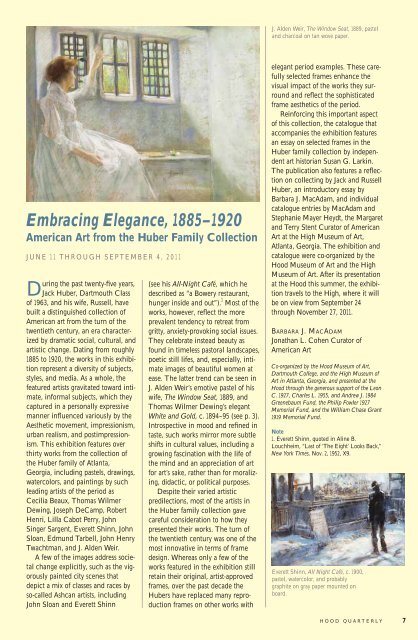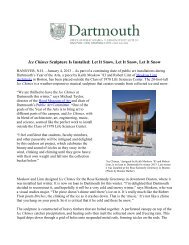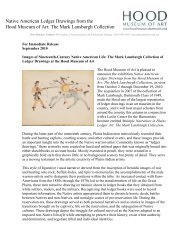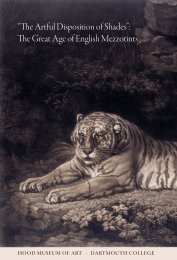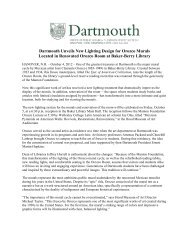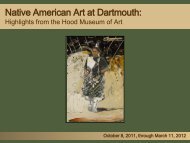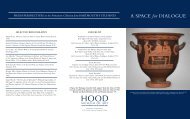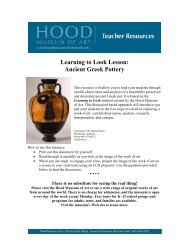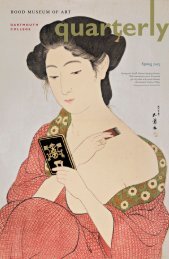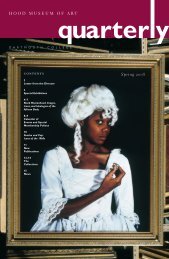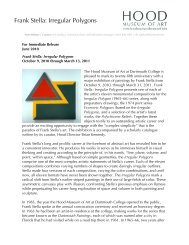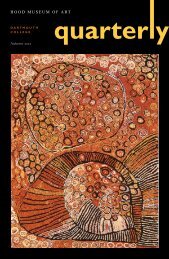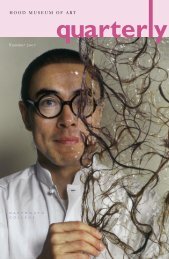Spring/Summer 2011 - Hood Museum of Art - Dartmouth College
Spring/Summer 2011 - Hood Museum of Art - Dartmouth College
Spring/Summer 2011 - Hood Museum of Art - Dartmouth College
You also want an ePaper? Increase the reach of your titles
YUMPU automatically turns print PDFs into web optimized ePapers that Google loves.
J. Alden Weir, The Window Seat, 1889, pastel<br />
and charcoal on tan wove paper.<br />
Embracing Elegance, 1885–1920<br />
American <strong>Art</strong> from the Huber Family Collection<br />
JUNE 11 THROUGH SEPTEMBER 4, <strong>2011</strong><br />
During the past twenty-five years,<br />
Jack Huber, <strong>Dartmouth</strong> Class<br />
<strong>of</strong> 1963, and his wife, Russell, have<br />
built a distinguished collection <strong>of</strong><br />
American art from the turn <strong>of</strong> the<br />
twentieth century, an era characterized<br />
by dramatic social, cultural, and<br />
artistic change. Dating from roughly<br />
1885 to 1920, the works in this exhibition<br />
represent a diversity <strong>of</strong> subjects,<br />
styles, and media. As a whole, the<br />
featured artists gravitated toward intimate,<br />
informal subjects, which they<br />
captured in a personally expressive<br />
manner influenced variously by the<br />
Aesthetic movement, impressionism,<br />
urban realism, and postimpressionism.<br />
This exhibition features over<br />
thirty works from the collection <strong>of</strong><br />
the Huber family <strong>of</strong> Atlanta,<br />
Georgia, including pastels, drawings,<br />
watercolors, and paintings by such<br />
leading artists <strong>of</strong> the period as<br />
Cecilia Beaux, Thomas Wilmer<br />
Dewing, Joseph DeCamp, Robert<br />
Henri, Lilla Cabot Perry, John<br />
Singer Sargent, Everett Shinn, John<br />
Sloan, Edmund Tarbell, John Henry<br />
Twachtman, and J. Alden Weir.<br />
A few <strong>of</strong> the images address societal<br />
change explicitly, such as the vigorously<br />
painted city scenes that<br />
depict a mix <strong>of</strong> classes and races by<br />
so-called Ashcan artists, including<br />
John Sloan and Everett Shinn<br />
(see his All-Night Café, which he<br />
described as “a Bowery restaurant,<br />
hunger inside and out”). 1 Most <strong>of</strong> the<br />
works, however, reflect the more<br />
prevalent tendency to retreat from<br />
gritty, anxiety-provoking social issues.<br />
They celebrate instead beauty as<br />
found in timeless pastoral landscapes,<br />
poetic still lifes, and, especially, intimate<br />
images <strong>of</strong> beautiful women at<br />
ease. The latter trend can be seen in<br />
J. Alden Weir’s emotive pastel <strong>of</strong> his<br />
wife, The Window Seat, 1889, and<br />
Thomas Wilmer Dewing’s elegant<br />
White and Gold, c. 1894–95 (see p. 3).<br />
Introspective in mood and refined in<br />
taste, such works mirror more subtle<br />
shifts in cultural values, including a<br />
growing fascination with the life <strong>of</strong><br />
the mind and an appreciation <strong>of</strong> art<br />
for art’s sake, rather than for moralizing,<br />
didactic, or political purposes.<br />
Despite their varied artistic<br />
predilections, most <strong>of</strong> the artists in<br />
the Huber family collection gave<br />
careful consideration to how they<br />
presented their works. The turn <strong>of</strong><br />
the twentieth century was one <strong>of</strong> the<br />
most innovative in terms <strong>of</strong> frame<br />
design. Whereas only a few <strong>of</strong> the<br />
works featured in the exhibition still<br />
retain their original, artist-approved<br />
frames, over the past decade the<br />
Hubers have replaced many reproduction<br />
frames on other works with<br />
elegant period examples. These carefully<br />
selected frames enhance the<br />
visual impact <strong>of</strong> the works they surround<br />
and reflect the sophisticated<br />
frame aesthetics <strong>of</strong> the period.<br />
Reinforcing this important aspect<br />
<strong>of</strong> this collection, the catalogue that<br />
accompanies the exhibition features<br />
an essay on selected frames in the<br />
Huber family collection by independent<br />
art historian Susan G. Larkin.<br />
The publication also features a reflection<br />
on collecting by Jack and Russell<br />
Huber, an introductory essay by<br />
Barbara J. MacAdam, and individual<br />
catalogue entries by MacAdam and<br />
Stephanie Mayer Heydt, the Margaret<br />
and Terry Stent Curator <strong>of</strong> American<br />
<strong>Art</strong> at the High <strong>Museum</strong> <strong>of</strong> <strong>Art</strong>,<br />
Atlanta, Georgia. The exhibition and<br />
catalogue were co-organized by the<br />
<strong>Hood</strong> <strong>Museum</strong> <strong>of</strong> <strong>Art</strong> and the High<br />
<strong>Museum</strong> <strong>of</strong> <strong>Art</strong>. After its presentation<br />
at the <strong>Hood</strong> this summer, the exhibition<br />
travels to the High, where it will<br />
be on view from September 24<br />
through November 27, <strong>2011</strong>.<br />
BARBARA J. MACADAM<br />
Jonathan L. Cohen Curator <strong>of</strong><br />
American <strong>Art</strong><br />
Co-organized by the <strong>Hood</strong> <strong>Museum</strong> <strong>of</strong> <strong>Art</strong>,<br />
<strong>Dartmouth</strong> <strong>College</strong>, and the High <strong>Museum</strong> <strong>of</strong><br />
<strong>Art</strong> in Atlanta, Georgia, and presented at the<br />
<strong>Hood</strong> through the generous support <strong>of</strong> the Leon<br />
C. 1927, Charles L. 1955, and Andrew J. 1984<br />
Greenebaum Fund, the Philip Fowler 1927<br />
Memorial Fund, and the William Chase Grant<br />
1919 Memorial Fund.<br />
Note<br />
1. Everett Shinn, quoted in Aline B.<br />
Louchheim, “Last <strong>of</strong> ‘The Eight’ Looks Back,”<br />
New York Times, Nov. 2, 1952, X9.<br />
Everett Shinn, All Night Café, c. 1900,<br />
pastel, watercolor, and probably<br />
graphite on gray paper mounted on<br />
board.<br />
HOOD QUARTERLY 7


